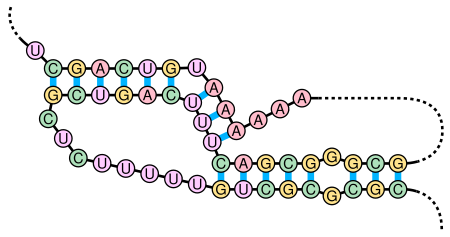Related: BCMB 412 Advanced Molecular Biology and Genomics
Summary
RNA is dynamic, and its secondary structure controls its function; therefore, influencing downstream effects
RNA pseudoknots are structural motifs that occur in single-stranded RNA. They form when specific regions of the RNA base-pair in a way that causes the molecule to fold back onto itself.

Caption: “naturally occurring pseudoknot found in human telomerase (Chen and Greider (2005))”
The structure can influence RNA stability and interactions with other molecules, such as proteins or ribosomes. For example, they can controlling access to the ribosome binding site, depending on environmental conditions like temperature.
Example in action: gene regulation of prfA gene expression in L. monocytogenes
In L. monocytogenes, the temperature-sensitive changes in the RNA structure determine whether translation can occur
Upon transcription, the prfA mRNA forms a stem-loop structure at low temperatures. This secondary structure blocks the ribosome binding site (RBS) of the prfA mRNA, preventing translation.